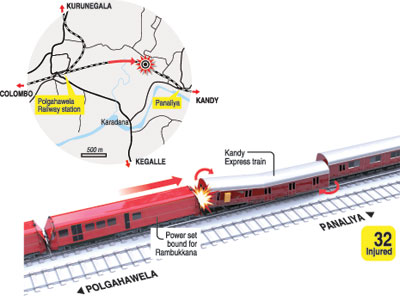News
Train accident waiting to happen due to poor engine design
S11 train engines and their poor safety design will certainly be reviewed by railway authorities and the government regardless of other findings from the investigation into the Polgahawela accident, the chief investigator in a previous railway accident said.
Professor R G N De S Munasinghe, professor of Materials Science and engineering at the University of Moratuwa and a former chairman of the committee appointed to inquire into the Alawwa Train Accident (2011), said the S11 engines had been involved in two previous accidents – including the incident at Alawwa – before last week’s accident at Polgahawela, and their poor fibreglass nose cones were too weak to withstand a collision.
At least 32 people were injured in Monday’s accident in Polgahawela when a train proceeding to Rambukkana hit a train stalled due to a technical defect on the same track.
“When I was appointed to look into the Alawwa accident I recommended they change the nose cones to an aluminium alloy. The ideal would be carbon fibre, which is better at absorbing the energy of an impact but, sadly, that is too costly.
“I don’t know if they redesigned the nose cones of these engines or not, and if so, with what material, because the committee was dissolved no sooner than we began our investigation,” Prof. Munasinghe said.
“Since then I lost interest in the matter: I was gutted by the fact that our committee was dissolved mid-investigation.”
The S11 engines are of inferior quality and are imported from India as part of a signed contract.
Prof. Munasinghe said the S11 brakes should also be investigated. “Even at the Alawwa accident, some of the engine drivers said the brakes [of that train] were faulty and when they had driven the train previously, they had done so with great caution.” The driver of the Alawwa train and his assistant both died in the accident and could not corroborate heir colleagues’ evidence.
The professor emphasised the importance of hiring an independent brake expert who was not employed by the Railways Department to help with the inquiry.
“An independent expert is needed because the findings of someone from within the department are often called foul by employees of other unions. This is a real problem in the Railways Department. There are many unions with different ideas and beliefs that accuse others of bias,” he said.
The S11 engine train heading to Rambukkana from Colombo Fort on August 6 rammed into the back of a Kandy-bound train that had stopped at Panaliya near Polgahawela. The accident bore a great resemblance to the one at Alawwa, which had five fatalities.
Attempts by the Sunday Times to contact the General Manager of Railways, S M Abeywickrama, who is also a member of the inquiry committee appointed by the Transport Minister, were unsuccessful. Another senior official in the Railways Department declined to comment, citing the ongoing investigations.
Dr. Lalithasiri Gunaruwan, a former general manager of the department and a senior lecturer at the University of Colombo, explained that a signals failure alone could not cause the kind of accident that occurred this week.
Railway signals were designed in such a way that even if they failed, they “failed to safety”, he said.
“If there is a fault in the signal it automatically turns red, indicating danger, even if there actually isn’t any danger. And suppose there is a problem with the light system and no light is displayed at all, it is assumed to be red and therefore train drivers are warned to take extreme precautions and be ready to stop at any moment,” Dr. Gunaruwan said.
“But sometimes the crew doesn’t pay heed to these signals. For example, not reducing the speed to 5mph at the amber signal makes it difficult to control the train at short notice were the signal to turn red,” he said.
“I am not implying, however, that it was one of these reasons that caused the Polgahawela accident. It is unwise to arrive at conclusions before the reports are published.”
Dr. Gunaruwan said that adopting technology such as automatic power cuts when two trains come close to each other could minimise certain accidents in the future.
“In some countries, the trains ‘read’ the signals too and react accordingly, with speed drops, if drivers fail to do so manually. The Sri Lanka Railway could make use of these in the future,” he said.
The former chief of the Railways Department emphasised the importance of punishment for those proved guilty of deliberate misconduct.
“The prescribed punishment should be carried out in full when a party is found guilty,” Mr. Gunaruwan said. “Sadly, I have witnessed lapses in this, and when that happens it assures people that they can do whatever they want and get away scot-free.”

